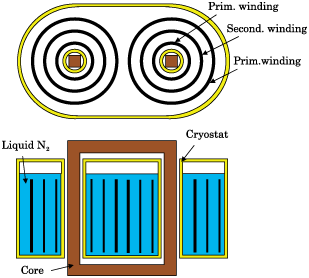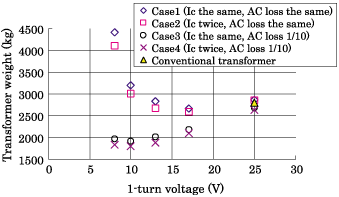
Fig.1 Basic structure of superconducting transformer (excluding refrigerator)
| Hiroshi HATA Chief Researcher | Hiroki KAMIJO Senior Researcher | Hiroyuki FUJIMOTO Chief Researcher | ||
| Traction control G., Vehicle control technology Div. | Superconducting materials G., Materials technology Div. | |||
1. Introduction
High Tc superconducting wires such as Bi2223 have made great progress in recent years. As a result, a prototype superconducting transformer rated around 1 MVA was manufactured. Its merits are lightweight and high efficiency. We have carried out a rough design study of a superconducting traction transformer to evaluate its merit. This work was carried out in conjunction with Kyushu University .
2. Premise for a design study
We assumed the specification of the transformer as Table 1 in consideration of the current design for Shinkansen type rolling stock.
| Input power | 3 MVA |
| Voltage (prim./second.) | 25 kV / 1 kV |
| Current (prim./second.) | 120 A / 1 kA~3 |
| Frequency | 60 Hz |

We assumed four cases for the design study. When compared with the present wire, the Ic and AC loss are:
| Case1: | Ic the same, AC loss the same |
| Case2: | Ic twice, AC loss the same |
| Case3: | Ic the same, AC loss 1/10 |
| Case4: | Ic twice, AC loss 1/10 |
3. Results
In all cases, we first determined the dimensions of windings and core. Then we carried out magnetic field distribution analysis for the windings and calculated the AC loss, which is a function of the magnetic field applied to the windings. Finally we calculated the weight of transformer including a refrigerator. The results are shown in Fig.2. As for the cases 1 and 2, the weight is around 2600 kg which is slightly lighter than that of conventional transformer. In the case 4, the minimum weight is around 1800 kg, 30% lighter.

| Case(Type) | Conventional | Superconducting |
| AC loss | ---- | 299 W |
| Other loss | 131 kW | 170 W |
| Refrigerator input | ---- | 12 kW |
| Efficiency | 95.8% | 99.4% |